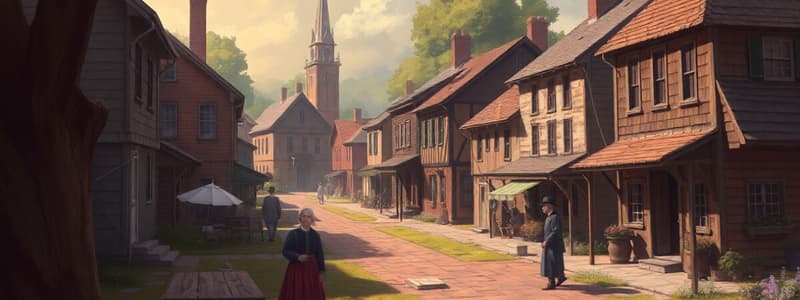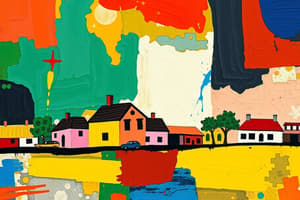Podcast
Questions and Answers
What was the ratio of city dwellers to the total population in a colonial American city during the 1750s?
What was the ratio of city dwellers to the total population in a colonial American city during the 1750s?
- 1 out of 20 (correct)
- 1 out of 15
- 1 out of 25
- 1 out of 10
Which of the following goods was NOT typically brought in by ships at the waterfront?
Which of the following goods was NOT typically brought in by ships at the waterfront?
- Books
- Clothing (correct)
- Paint
- Furniture
What type of service was offered at local shops in colonial American cities?
What type of service was offered at local shops in colonial American cities?
- Navigation
- Spice trading
- Clockmaking (correct)
- Animal husbandry
What types of products were available in the market place?
What types of products were available in the market place?
Which of the following establishments primarily provided food and drinks in the city?
Which of the following establishments primarily provided food and drinks in the city?
What was a common form of punishment for theft in Colonial America?
What was a common form of punishment for theft in Colonial America?
What was the primary construction material used for homes in the described 19th-century town?
What was the primary construction material used for homes in the described 19th-century town?
Which of the following describes the role of Colonial Assemblies in the context of crimes and punishments?
Which of the following describes the role of Colonial Assemblies in the context of crimes and punishments?
Which feature contributed most to the noise level in Shelly Place?
Which feature contributed most to the noise level in Shelly Place?
Which event exemplified the fear of witchcraft among the New England Puritans?
Which event exemplified the fear of witchcraft among the New England Puritans?
What was a common health issue indicated by the town's sanitation conditions?
What was a common health issue indicated by the town's sanitation conditions?
What consequences did individuals face for lesser crimes such as drunkenness in New England?
What consequences did individuals face for lesser crimes such as drunkenness in New England?
What method of lighting was primarily used in the homes of the town?
What method of lighting was primarily used in the homes of the town?
What was a key characteristic of the Puritan moral code in Colonial America?
What was a key characteristic of the Puritan moral code in Colonial America?
How did the townspeople address fire safety concerns?
How did the townspeople address fire safety concerns?
What fundamental concept did the Magna Carta introduce regarding the power of the monarch?
What fundamental concept did the Magna Carta introduce regarding the power of the monarch?
What key power regarding taxation was affirmed by the English Bill of Rights of 1689?
What key power regarding taxation was affirmed by the English Bill of Rights of 1689?
Which of the following rights was explicitly granted to the people by the English Bill of Rights?
Which of the following rights was explicitly granted to the people by the English Bill of Rights?
What was one expectation of the colonists regarding their role in government?
What was one expectation of the colonists regarding their role in government?
Which of the following statements about the rights granted by the English Bill of Rights is incorrect?
Which of the following statements about the rights granted by the English Bill of Rights is incorrect?
What defines the upper class in Colonial America?
What defines the upper class in Colonial America?
Which characteristic is associated with the middle class in Colonial America?
Which characteristic is associated with the middle class in Colonial America?
What was a major component of the lower class in Colonial America?
What was a major component of the lower class in Colonial America?
What proportion of New England settlers was considered to be part of the middle class?
What proportion of New England settlers was considered to be part of the middle class?
Which of the following was NOT a typical feature of the upper class attire in Colonial America?
Which of the following was NOT a typical feature of the upper class attire in Colonial America?
What was a significant factor that contributed to the expansion of slavery in Colonial America during the 1700s?
What was a significant factor that contributed to the expansion of slavery in Colonial America during the 1700s?
Which of the following statements accurately describes the Middle Passage?
Which of the following statements accurately describes the Middle Passage?
What type of tasks were slaves commonly expected to perform on plantations?
What type of tasks were slaves commonly expected to perform on plantations?
Where did the majority of slaves in Colonial America originate from?
Where did the majority of slaves in Colonial America originate from?
In the social hierarchy of Colonial America, where did slaves position themselves?
In the social hierarchy of Colonial America, where did slaves position themselves?
What were the potential consequences faced by individuals who rebelled or ran away?
What were the potential consequences faced by individuals who rebelled or ran away?
Which of the following actions represents a response to rebellion documented in the notes?
Which of the following actions represents a response to rebellion documented in the notes?
What can be inferred about the severity of consequences for rebels based on the notes?
What can be inferred about the severity of consequences for rebels based on the notes?
How does the content categorize the fate of those who attempted to rebel?
How does the content categorize the fate of those who attempted to rebel?
What implication does the mention of 'Killed/Hang' and 'Beaten' suggest about societal attitudes toward rebellion?
What implication does the mention of 'Killed/Hang' and 'Beaten' suggest about societal attitudes toward rebellion?
Flashcards are hidden until you start studying
Study Notes
Life in a Colonial American City (1750s)
- Only 1 in 20 people lived in a city during this time period.
- Ships brought news from England and goods like furniture, paint, carpets, and books.
- Fresh farm products such as eggs, milk, and cheese were available in the market place.
- Taverns provided food and drinks.
- Shops offered services like blacksmithing, shoemaking, clockmaking, silversmithing, tailoring, barbering, and wig-making.
19th Century Town
- Shelly Place was described as a noisy environment.
- The weather was noted as being hot.
- Sounds from church bells and carts were common.
- Mosquitoes and flies were prevalent pests.
- Rotten garbage was found in the streets.
- Cobblestone streets were present.
Homes
- Homes were built close together.
- They were constructed with wood and thatched roofs.
- Small windows were common, as glass was expensive.
Lighting
- Torches, "betty lamps," both grease, and candles were used for lighting.
Fire Safety
- The town relied on a bucket system to combat fires, with everyone participating.
- The river or pond served as the water source.
Political Rights of the Colonists
- The Magna Carta established that the monarch's power was limited.
- The English Bill of Rights (1689) established that taxing power belonged to elected representatives.
- This document granted rights like the right to petition the King and the right to trial by jury.
- Colonists expected to have a voice in government and expected to elect some representatives.
Colonial American Crimes and Punishments
- Colonial assemblies were responsible for creating their own laws and penalties for crimes.
- Death was a punishment for serious crimes.
- Crimes like theft, forgery, and highway robbery could result in jail time, whippings, or branding.
- Drunkenness and Sabbath breaking were considered lesser crimes, with punishments like stocks.
New England Puritans
- Puritans had strict moral codes and emphasized religious conformity.
- Sunday worship was mandatory.
- "Blue Laws" were enacted to regulate social behavior based on religious or moral principles.
- There was a fear of witchcraft and evil.
- The Salem Witch Trials took place in 1692 where 29 women were falsely accused of witchcraft.
Colonial American Class Differences
- Upper-class individuals were defined by wealth, occupations, and inherited titles or honors. They often wore gold and silver clothing, wigs, boots, and breeches.
- The middle class consisted of farmers, artisans, craft people, or those who owned their own land or business. They could vote and wore plain or colorful clothing.
- The lower class included farm laborers or workers with little or no property. They were wage earners and did not have the right to vote.
- A significant portion of the lower class was made up of indentured servants and slaves.
- Approximately one-third of New England settlers were of the middle class.
- In the middle colonies, roughly half of the population belonged to the middle class.
Slavery in Colonial America
- Africans first arrived in Virginia in the 1700s.
- The practice of slavery expanded rapidly.
- Increased plantation development and the growth of cash crops like tobacco, rice, and indigo created a greater need for slaves.
- Slaves originated from West Africa and were traded for goods like cloth, guns, and rum.
- The "Middle Passage" was the brutal journey across the Atlantic.
- Conditions were horrific, crowded, and lacked food and warmth.
- Diseases spread rapidly, leading to high death rates among slaves on board the ships.
- Slaves worked in the fields, raising crops, and performing various other labor.
- Some specialized jobs included caring for horses, carpentry, blacksmithing, gardening, and midwifery.
- Slaves were located at the bottom of the social hierarchy.
- Some slaves rebelled or ran away. Consequences for these actions could include death, hanging, or beatings.
Studying That Suits You
Use AI to generate personalized quizzes and flashcards to suit your learning preferences.




